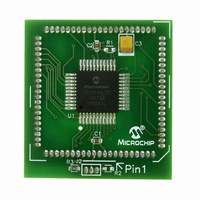MA180023 Microchip Technology, MA180023 Datasheet - Page 255

MA180023
Manufacturer Part Number
MA180023
Description
MODULE PLUG-IN PIC18F46J11 PIM
Manufacturer
Microchip Technology
Series
PIC®r
Datasheet
1.MA180023.pdf
(528 pages)
Specifications of MA180023
Accessory Type
Plug-In Module (PIM) - PIC18F46J11
Tool / Board Applications
General Purpose MCU, MPU, DSP, DSC
Mcu Supported Families
PIC18
Supported Devices
Stand-alone Or W/ HPC(DM183022) Or PIC18(DM183032)
Silicon Manufacturer
Microchip
Core Architecture
PIC
Core Sub-architecture
PIC18
Silicon Core Number
PIC18F
Silicon Family Name
PIC18FxxJxx
Lead Free Status / RoHS Status
Lead free / RoHS Compliant
For Use With/related Products
HPC Explorer Board (DM183022) or PIC18 Explorer Board (DM183032)
For Use With
DM183032 - BOARD EXPLORER PICDEM PIC18DM183022 - BOARD DEMO PIC18FXX22 64/80TQFP
Lead Free Status / RoHS Status
Lead free / RoHS Compliant
Available stocks
Company
Part Number
Manufacturer
Quantity
Price
Company:
Part Number:
MA180023
Manufacturer:
Microchip Technology
Quantity:
135
- Current page: 255 of 528
- Download datasheet (8Mb)
17.5.2.1
In the Full-Bridge mode, the PxM1 bit in the CCPxCON
register allows users to control the forward/reverse
direction. When the application firmware changes this
direction control bit, the module will change to the new
direction on the next PWM cycle.
A direction change is initiated in software by changing
the PxM1 bit of the CCPxCON register. The following
sequence occurs prior to the end of the current PWM
period:
• The modulated outputs (PxB and PxD) are placed
• The associated unmodulated outputs (PxA and
• PWM modulation resumes at the beginning of the
See Figure 17-12 for an illustration of this sequence.
The Full-Bridge mode does not provide a dead-band
delay. As one output is modulated at a time, a
dead-band delay is generally not required. There is a
situation where a dead-band delay is required. This
situation occurs when both of the following conditions
are true:
FIGURE 17-12:
© 2009 Microchip Technology Inc.
in their inactive state.
PxC) are switched to drive in the opposite
direction.
next period.
Note 1: The direction bit, PxM1 of the CCPxCON register, is written any time during the PWM cycle.
PxA (Active-High)
PxB (Active-High)
PxC (Active-High)
PxD (Active-High)
2: When changing directions, the PxA and PxC signals switch before the end of the current PWM cycle. The
Signal
Direction Change in Full-Bridge
Mode
modulated PxB and PxD signals are inactive at this time. The length of this time is:
(1/F
OSC
) • TMR2 Prescale Value
EXAMPLE OF PWM DIRECTION CHANGE
Pulse Width
Period
(1)
PIC18F46J11 FAMILY
1.
2.
Figure 17-13 shows an example of the PWM direction
changing from forward to reverse, at a near 100% duty
cycle. In this example, at time, t1, the PxA and PxD
outputs become inactive, while the PxC output
becomes active. Since the turn-off time of the power
devices is longer than the turn-on time, a shoot-through
current will flow through power devices, QC and QD
(see Figure 17-10), for the duration of ‘t’. The same
phenomenon will occur to power devices, QA and QB,
for PWM direction change from reverse to forward.
If changing PWM direction at high duty cycle is required
for an application, two possible solutions for eliminating
the shoot-through current are:
1.
2.
Other options to prevent shoot-through current may
exist.
The direction of the PWM output changes when
the duty cycle of the output is at or near 100%.
The turn-off time of the power switch, including
the power device and driver circuit, is greater
than the turn-on time.
Reduce PWM duty cycle for one PWM period
before changing directions.
Use switch drivers that can drive the switches off
faster than they can drive them on.
Pulse Width
(2)
Period
DS39932C-page 255
Related parts for MA180023
Image
Part Number
Description
Manufacturer
Datasheet
Request
R

Part Number:
Description:
Manufacturer:
Microchip Technology Inc.
Datasheet:

Part Number:
Description:
Manufacturer:
Microchip Technology Inc.
Datasheet:

Part Number:
Description:
Manufacturer:
Microchip Technology Inc.
Datasheet:

Part Number:
Description:
Manufacturer:
Microchip Technology Inc.
Datasheet:

Part Number:
Description:
Manufacturer:
Microchip Technology Inc.
Datasheet:

Part Number:
Description:
Manufacturer:
Microchip Technology Inc.
Datasheet:

Part Number:
Description:
Manufacturer:
Microchip Technology Inc.
Datasheet:

Part Number:
Description:
Manufacturer:
Microchip Technology Inc.
Datasheet:











